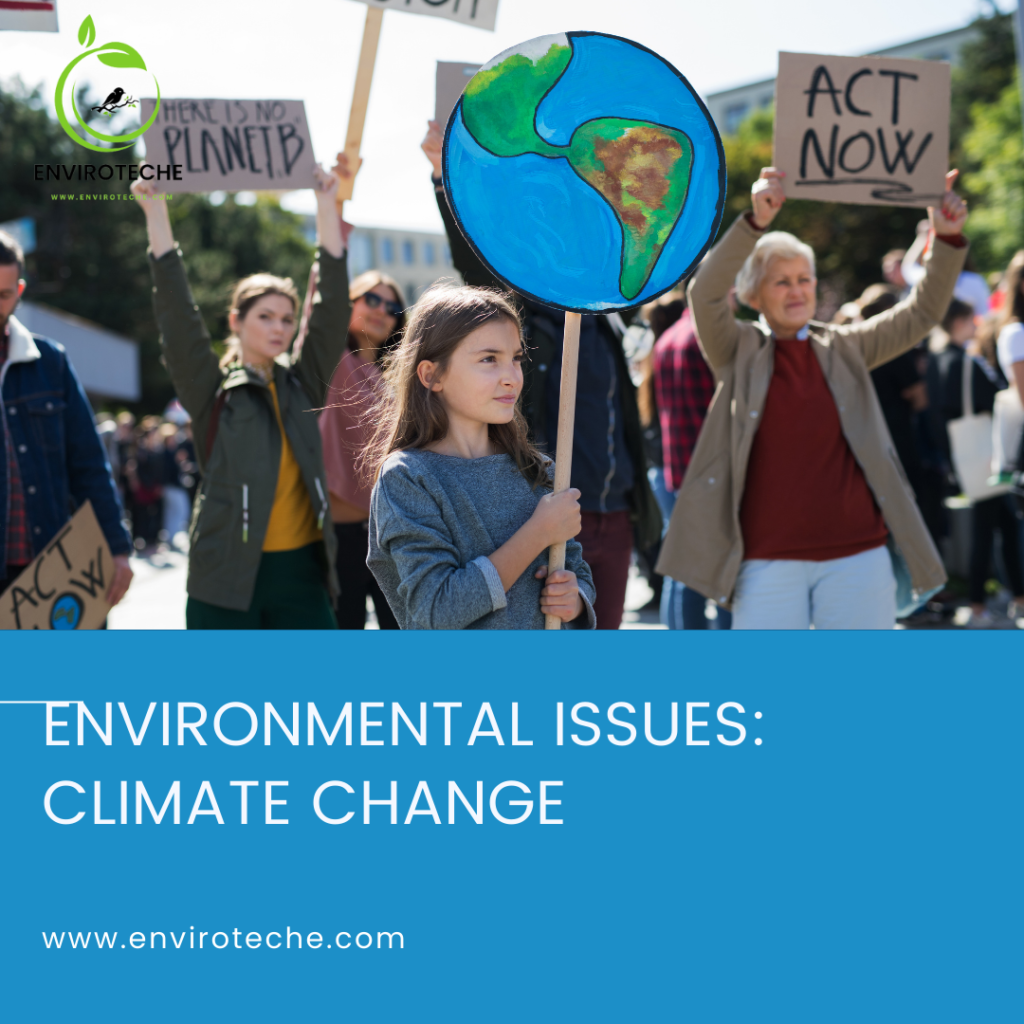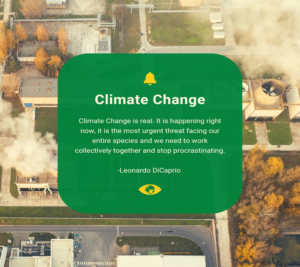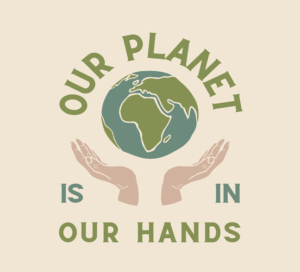Table of Contents

ENVIRONMENTAL ISSUES: CLIMATE CHANGE
What is Climate Change?
The average weather in any area over a long period. It comprises the knowledge of weather like rainfall, thunder, sunshine, or humidity.
Climate change is a term that refers to the change in the average rate temperature of any area over a long period. Generally, it is a shift in Earth’s climate at local, regional, and global scales for a long duration. Natural variations in atmospheric condition have occurred throughout human history.
Scientists have proved that this shift is happening due to the widespread of fossil fuels by humans– coal, oil, and gas – in homes, factories, and transport. Fossil fuels are made from the decomposition of plants and animals, found on Earth’s crust that hold carbon dioxide and hydrogen. So these are all hydrocarbons, that’s why they trap the heat of the Sun in the atmosphere and cause the rise of the rated temperature on the planet.

Humans are also the origin of greenhouse gases, for example, carbon dioxide, methane, and nitrous oxide. Burning fossil fuels (gasoline or coal) generates greenhouse gases that act like a blanket wrapped around the Earth. These greenhouse gases are also known as heat-trapping gases. In this way, those gases in the atmosphere raise the surface rate temperature of the planet, such as Earth.
The emission of these harmful gases occurs due to the burning of fossils, cutting of trees, clearing land, agriculture oil, gas operations, energy, industries, transports, buildings, and manufacturing goods, resulting in a rapid increase in carbon dioxide concentration in the atmosphere of the Earth.
Causes of Climate Change (ENVIRONMENTAL ISSUES: CLIMATE CHANGE)
The cause of climate change is anthropogenic (caused by human action or inaction).
Human activities have revealed the impacts on the rate of temperature of the Earth. Natural processes such as the change in the Sun’s energy and volcanic eruptions also affect the Earth’s climate. Here are some causes of climate change:
Deforestation
The cutting of trees is known as deforestation. It involves the conversion of forests into farms or for civil use. It is challenging for all of us to overlook the significance of forests. They are home to some species, used as a source of oxygen, medicine, and food, and they sustain a million jobs. Forests are crucial to reduce the rate of global warming. They maintain the rated temperature of the planet by producing oxygen and water vapors. Wood is composed of carbon. When it burns, it releases carbon dioxide.
Human activities emit over 30 billion tons of carbon dioxide into the atmosphere every year. As of 2021, deforestation accounted for 10% maintaining global warming. There are some reasons for cutting down trees, like the area for housing, agriculture, logging, and the production of wood products (palm oil and soybean).
The loss of forests is not only the source of global warming but also a cause of soil erosion and loss of biodiversity.
Transportation
Vehicles like cars, trucks, motorcycles, planes, and ships consume fossil fuels and gasoline, which is the expert of greenhouse gases (carbon dioxide and methane).
It is a modern era, and people crave comfort and calmness. They prefer personal transport for every purpose instead of public transportation. These transports emit hazardous gases. When these gases penetrate the environment, they prompt heat. As a result, climate change occurs in the form of heat-strokes or global warming.
Fluorinated Gases
The gases used in refrigerators, air conditioners, and heat pump equipment are massive sources of fluorinated gases made up of hydrofluorocarbons, perfluorocarbons, sulfur hexafluoride, and nitrogen Trifluoride. These gases are dominant greenhouse gases (do not occur in nature) that lead to the fabrication of heat and air pollution. All these gases are emitted from households, commercial, and industrial processes (aluminum production and electrical transmission).
Ocean Current
The continual, foreseeable, and directional action of seawater is known as ocean current. It often carries heat around the Earth. Oceans absorb more heat, but when the ocean’s rate of temperature expands, the circulation pattern of oceans around the globe changes. A small change in the movement of seawater causes a severe impact on climate change. The movement of seawater causes the increase of rate temperature on the sea surface that leads to the water vapors over the oceans. In this way, oceans are warmer by their movement, and then they cannot absorb more heat and carbon dioxide from the atmosphere.
Generating Electric Power
The process of generating electricity and heat by the burning of fossil fuels is a source of global emissions. Coal, crude oil, and gas are the basic sources of electricity production. The consumption of all these gases produces greenhouse gases, which lead to global warming. The usage of fossil fuels is hazardous to humans, plants, animals, and wildlife and their habitats. The emission of these harmful gases is the root of the death of plants and the loss of species.
Presently, renewable energy sources such as wind and solar power can only generate a quarter of electricity. Renewable energy sources emit minute or completely blocked greenhouse gases or pollutants.
Effects of Climate Change
Climate change is a complex and multifaceted phenomenon that is affecting the entire planet. Some effects of climate change are being felt around the globe.
Ascending the rate of Temperature:
As we all know, the greenhouse effect is the major cause of climate change. Greenhouse gases act similarly to an absorbing envelope that absorbs heat from the Sun and transfers it to the environment. Further, greenhouses provide no way to escape that heat from the environment. So with time that heat piled up in the environment and increased the rate of temperature on Earth.
According to researchers, the global temperature increased 1.98°F (1.1°C) from 1901 to 2020. It is said that 2020 is the warmest year in the history of the Earth. Raising the temperature not only affects the climate but also the lives of many people. Heat-related illness and heat strokes are the major effects on human beings. Due to hotter temperatures millions of people die daily. Hotter temperatures make it difficult for people to work and go around. Animal life is also being affected by it. Many plants are becoming dry and lifeless due to increasing the intensity of temperature.
Rising the level of Ocean
Water absorbs much amount of energy as compared to something else. As we are aware global warming causing an increase in the temperature in the environment so oceans are also getting warmer. Due to the greenhouse effect, ice sheets are melting causing a rise in the sea level.
It’s a fact that whenever water gets warmer, its volume increases. So due to heat, the Volume of water increases, causing a shortage of area for water deposition. So water flows out in the form of floods or storms. These disasters affect the normal lives of people. Mostly coastal and island population is severely affected by such things. It makes people both economically and physically destructive and makes the environment more and more warmer.
Chances of the drought
Climate change is a big reason for the deficiency of water in some areas. In such places, change in climate affects the average rainfall. Mostly destructive sand storms affect these areas. Many people have to face a shortage of water. Not only are their domestic life affected by this scarcity of water, but their crops are also affected.
In such matters, they are fully dependent on natural rainfalls. Many lives were lost due to the attack of drought in such areas. Human beings, animals, and floral fields are all affected in those places. Deserts are expanding swiftly due to climate change, reducing the areas for food fields.
Unexpected severe Storms
Climate change is affecting the temperature of Earth causing a big change in rainfall. There is no specific time of rainfall regarding climate. Unexpectedly, a lot of rainfall takes place which causes flooding and somehow landsliding. These floods cause severe storms that destroy many communities and human lives. Millions of houses and buildings are destroyed under these storms. With the passage of time storms are getting worse that are affecting the lives more severely.
Depletion of the Ozone Layer
Ozone is a protective layer around the Earth. It keeps us safe from the hazardous ultraviolet rays of the Sun. However, due to climate change and global warming, this layer is becoming thinner and thinner.
The effect of this thin layer is that all the harmful radiations from the Sun are directly casting on the life and health of human beings. These radiations cause a lot of human diseases like cancer, and sunburn of the skin, and weaken the human immune system. According to researchers, in the coming years, its effects become more severe and these diseases will be common among people.
Preventions of Climate Change
The slightest mutation in climate is a severe threat to all the beings on Earth. We need to stop these threats by prohibiting and encouraging the following actions. We should:
Forbid deforestation strictly and promote afforestation.
Reduce the usage of fossil fuels and air conditioners.
Encourage the sources of renewable energy instead of burning fossil fuels for the sake of electricity production.
Avoid personal transport while public transport should be preferred.
Promote to preserve energy at home by switching off the extra lights and fans.
Try to make policies and regulations to avoid climate change.
Elevate the use of natural resources rather than artificiality.
Assist farming and encourage people to eat vegetables rather than meat so that the plantation process is promoted.
Protect the marine sources and life.
Follow 3Rs of recycling (reduce, reuse, recycle).
Prohibit the use of plastics.

FAQs
What is meant by climate change?
Climate change is a term that refers to the change in the average rate temperature of any area over a long period. Generally, it is a shift in Earth’s climate at local, regional, and global scales for a long duration. Climate has variated naturally throughout the world’s history.
- What is deforestation?
The cutting of trees is known as deforestation. It involves the conversion of forests into farms or for civil use.
- What are the causes of climate change?
The major causes of climate change are deforestation, transportation, greenhouse gases, and fluorinated gases.
- What are the effects of the depletion of the ozone layer?
Ozone is a protective layer around the Earth that shields us from the harmful ultraviolet radiation from the Sun. The effect of this thin layer is that all the harmful radiations from the Sun are directly casting on the life and health of human beings. These radiations cause a lot of human diseases like cancer, and sunburn of the skin, and weaken the human immune system.
- What are the 3Rs in recycling?
Reduce, reuse, and recycle model. These “Three Rs” play an important role in the protection of our planet.
References
McGrath, M., 2019. Climate change: July set to be the world’s warmest month on record. BBC News Climate and Science.
Ashford, E., 2007. The duties imposed by the human right to necessities. In: T, Pogge ed., Freedom from poverty as a human right: who owes what to the very poor? Oxford: Oxford University Press. ENVIRONMENTAL ISSUES: CLIMATE CHANGE ENVIRONMENTAL ISSUES: CLIMATE CHANGE
Baier, A., 1981. The rights of past and future persons. In: E. Partridge ed., Responsibilities to future generations: environmental ethics. New York: Prometheus Books ENVIRONMENTAL ISSUES: CLIMATE CHANGE ENVIRONMENTAL ISSUES: CLIMATE CHANGE ENVIRONMENTAL ISSUES: CLIMATE CHANGE
Caney, S., 2005. Justice beyond borders: a global political theory. Oxford: Oxford University Press. ENVIRONMENTAL ISSUES: CLIMATE CHANGE ENVIRONMENTAL ISSUES: CLIMATE CHANGE ENVIRONMENTAL ISSUES: CLIMATE CHANGE
Caney, S., 2009c. Climate change and the future: discounting for time, wealth, and Risk’, unpublished paper. ENVIRONMENTAL ISSUES: CLIMATE CHANGE
Confalonieri, U., Menne, B., Akhtar, R., Ebi, K., Hauengue, M., Kovats. R., Revich, B. and Woodward, A., 2007. Human health. In: M. Parry, O. Canziani, J. Palutikof,P. van der Linden and C. Hanson, eds., Climate change 2007: impacts, adaptation And vulnerability. Contribution of working group II to the fourth assessment report of the Intergovernmental Panel on Climate Change. Cambridge: Cambridge University Press. ENVIRONMENTAL ISSUES: CLIMATE CHANGE ENVIRONMENTAL ISSUES: CLIMATE CHANGE ENVIRONMENTAL ISSUES: CLIMATE CHANGE
IPCC, 2018: Summary for Policymakers. In: Global Warming of 1.5°C. An IPCC Special Report on the impacts of global warming of 1.5°C above pre-industrial levels and related global greenhouse gas emission pathways, in the context of strengthening the global response to the threat of climate change, sustainable development, and efforts to eradicate poverty [Masson-Delmotte, V., P. Zhai, H.-O. Pörtner, D. Roberts, J. Skea, P.R. Shukla, A. Pirani, W. Moufouma-Okia, C. Péan, R. Pidcock, S. Connors, J.B.R. Matthews, Y. Chen, X. Zhou, M.I. Gomis, E. Lonnoy, T. Maycock, M. Tignor, and T. Waterfield (eds.)]. Cambridge University Press, Cambridge, UK and New York, NY, USA, pp. 3-24, doi:10.1017/9781009157940.001. ENVIRONMENTAL ISSUES: CLIMATE CHANGE
Author Detail:
Marriam Bibi, Zunaira Rehman
Department of English, University of Education, Lahore
Check Other Scholarships:


